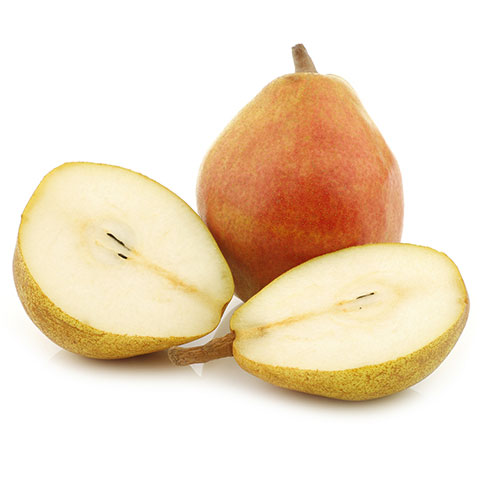From D’Anjou to Seckel: The Pleasure of Pears
- By Miriam Wolf
- Reading Time: 3 mins.
 Pears have been with us for centuries—dried slices of the fruit have been found in cave dwellings in Switzerland dating back to the Ice Age, and written documentation of the pear goes back 2,500 years. It’s been celebrated in art and literature, including Shakespeare: in The Merry Wives of Windsor, Falstaff fears the court will “whip me with their fine wits till I were as crest-fallen as a dried pear.”
Pears have been with us for centuries—dried slices of the fruit have been found in cave dwellings in Switzerland dating back to the Ice Age, and written documentation of the pear goes back 2,500 years. It’s been celebrated in art and literature, including Shakespeare: in The Merry Wives of Windsor, Falstaff fears the court will “whip me with their fine wits till I were as crest-fallen as a dried pear.”
Renaissance art also includes depictions of the pear, both as a sacred symbol in paintings of the Madonna and in other fruit-centered visual feasts. The fruit’s form is so pleasing, it has starred in many a still life.
We love pears not only for their form, but also for their function—buttery as a fine chardonnay, subtly perfumed, and meltingly tender, a perfectly ripe pear can be a sublime eating experience. And from the velvety sophistication of the diminutive Seckel pear to the juice-gushing delight of a ripe Bartlett, there is a variety of pear to fit almost every taste.
Want farm-fresh fruit?
We've got you covered.Pears to Try This Fall
Forelle
Forelle means “trout” in German. But never fear—this pear doesn’t taste like fish! “Forelle” refers to the pear’s coloring, which resembles a trout’s—a red blush speckled with dots known as lenticels. This old European variety is small in size and sweet in character, making it a perfect treat to tuck inside a child’s lunch box.
 Seckel
Seckel
The Seckel is the smallest commercially grown pear. It stays a bit crisp even when ripe, and is so sweet that it’s sometimes called a “sugar pear.”
 Bosc
Bosc
Discovered in the early 1800s and named after M. Bosc, a cultivator and the eventual director of the Paris Botanical Garden, the Bosc pear is the most handsome and distinctive variety. It features a long, graceful neck and all-over russeting.
 Bartlett
Bartlett
This remarkably juicy pear has a flavor that is the very essence of pear-dom. Because it’s so tender, it breaks down easily when cooked and makes a terrific pear sauce.
Want farm-fresh fruit?
We've got you covered. D’Anjou
D’Anjou
D’Anjou pears are one of the most commonly cultivated pears in the U.S. Unlike the super tender Bartlett, these sweet, oval pears hold their shape, making them great for salads or pear tarts.
 Comice
Comice
This exquisitely flavorful, creamy pear makes a great treat eaten out of hand. Eat it with soft cheese, or try poaching a few with ginger and vanilla for an elegant dessert.
Healthy Snacks
Like all fruits and vegetables, pears are a healthy snack. They are low in calories and pack a hefty fiber punch—in fact, their fiber content is among the highest of all fruits. Fiber helps digestion and can prevent colon cancer; studies show that most of us don’t even get close to the recommended daily amount of it.
Pears (especially their skins) are also rich in antioxidants and anti-inflammatory nutrients. These can help cells stay healthy and ward off chronic disease. Recent research has also linked the flavonoids in pears to improved insulin sensitivity, meaning that eating pears can help reduce your risk of developing type 2 diabetes.
Pears come into their peak season at the beginning of fall, but to preserve their bounty for months to come, try your hand at canning them.
Want farm-fresh fruit?
We've got you covered.
Miriam Wolf is the editor of The FruitGuys Magazine newsletter.


